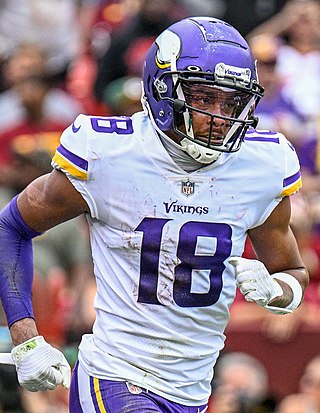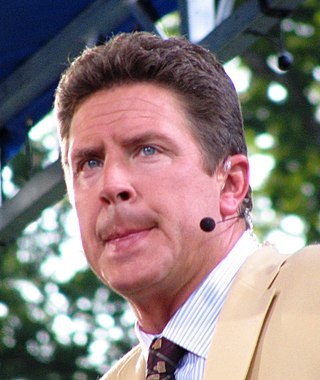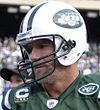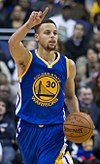
Peyton Williams Manning is an American former football quarterback who played in the National Football League (NFL) for 18 seasons. Nicknamed "the Sheriff", he spent 14 seasons with the Indianapolis Colts and four with the Denver Broncos. Manning is considered to be one of the greatest quarterbacks of all time. A member of the Manning football dynasty, he is the second son of former NFL quarterback Archie Manning and an older brother of former NFL quarterback Eli Manning. He played college football at Tennessee, where he won the Maxwell, Davey O'Brien, and Johnny Unitas Golden Arm Awards as a senior en route to victory in the 1997 SEC Championship.

An ESPY Award is an accolade currently presented by the American broadcast television network ABC, and previously ESPN, to recognize individual and team athletic achievement and other sports-related performance during the calendar year preceding a given annual ceremony. The first ESPYs were awarded in 1993. Because of the ceremony's rescheduling prior to the 2002 iteration thereof, awards presented in 2002 were for achievement and performances during the seventeen-plus previous months. As the similarly styled Grammy, Emmy, Academy Award, and Tony, the ESPYs are hosted by a contemporary celebrity; the style, though, is lighter, more relaxed and self-referential than many other awards shows, with comedic sketches usually included.

The Associated Press NFL Offensive Player of the Year Award (OPOY) is given annually by the Associated Press (AP) to the offensive player in the National Football League (NFL) deemed to have had the most outstanding season. The winner is chosen by votes from a nationwide panel of sportswriters who regularly follow the NFL. Multiple-time awardees include Marshall Faulk and Earl Campbell, both of whom won the award three times, each consecutively. Jerry Rice, Barry Sanders, Tom Brady, Terrell Davis, Drew Brees, and Peyton Manning have each won the award twice. The award is currently held by wide receiver Justin Jefferson of the Minnesota Vikings, who received it for the 2022 NFL season after being on pace to break Calvin Johnson record for most receiving yards in a single season in NFL history with 127 receptions, 8 touchdowns and 1,809 yards.
The Best Female Athlete ESPY Award, known alternatively as the Outstanding Female Athlete ESPY Award, has been presented annually at the ESPY Awards since 1993 to the female voted to be, irrespective of nationality or sport contested, the best athlete in a given calendar year. Between 1993 and 2004, the award voting panel comprised variously of fans; sportswriters and broadcasters, sports executives, and retired sportspersons, termed collectively experts; and ESPN personalities, but balloting thereafter has been exclusively by fans over the Internet from amongst choices selected by the ESPN Select Nominating Committee. Through the 2001 iteration of the ESPY Awards, ceremonies were conducted in February of each year to honor achievements over the previous calendar year; awards presented thereafter are conferred in June and reflect performance from the June previous.
The Best Male Athlete ESPY Award, known alternatively as the Outstanding Male Athlete ESPY Award, is an annual award honoring the achievements of individual men from the world of sports. It has been presented annually at the ESPY Awards since 1993 to the male voted irrespective of nationality or sport contested, adjudged to be the best athlete in a given calendar year. The Best Male Athlete ESPY Award trophy, designed by sculptor Lawrence Nowlan, is presented to the recipient at an annual ceremony in Los Angeles. Since 2004, the winner has been chosen by online balloting through three to five choices selected by the ESPN Select Nominating Committee. Before that, determination of the winners was made by an panel of experts. Through the 2001 iteration of the ESPY Awards, ceremonies were conducted in February of each year to honor achievements over the previous calendar year; awards presented thereafter are conferred in July and reflect performance from the June previous.
The Best NFL Player ESPY Award has been presented annually since 1993 to the National Football League player adjudged to be the best in a given calendar year, namely in the NFL season immediately precedent to the holding of the ESPY Awards ceremony.
The Best Driver ESPY Award, known alternatively as the Best Auto Racing Driver ESPY Award, is an annual award honoring the achievements of an individual from the world of motorsports. It was first awarded as part of the ESPY Awards in 1993. The Best Driver ESPY Award trophy, designed by sculptor Lawrence Nowlan, has been presented annually to the racing driver adjudged to have performed the best in a given calendar year. Since 2004, the winner has been chosen by online voting through three to five choices selected by the ESPN Select Nominating Committee. Before that, determination of the winners was made by an panel of experts. Through the 2001 iteration of the ESPY Awards, ceremonies were conducted in February of each year to honor achievements over the previous calendar year; awards presented thereafter are conferred in July and reflect performance from the June previous.
The ESPY Award for Best College Athlete, Women's Sports, known before 2021 as the Best Female College Athlete ESPY Award, is an annual award honoring the achievements of a female individual from the world of collegiate sports. It was first presented as part of the ESPY Awards in 2002, following the subsumption of the Best Female College Basketball Player ESPY Award, which was presented annually between the 1993 and 2001 ceremonies, inclusive. The award trophy, designed by sculptor Lawrence Nowlan, is awarded to the sportswoman adjudged to be the best in a given calendar year of those contesting collegiate sport in the United States through the National Collegiate Athletic Association (NCAA). Since the 2004 awards, the winner has been chosen by online voting through three to five nominees selected by the ESPN Select Nominating Committee. Before that, determination of the winners was made by an panel of experts. Through the 2001 iteration of the ESPY Awards, ceremonies were conducted in February of each year to honor achievements over the previous calendar year; awards presented thereafter are conferred in July and reflect performance from the June previous.
The Best Outdoor Sportsman ESPY Award was an annual award honoring the achievements of an athlete from the world of outdoor sports —understood as those related to outdoor recreation and nature-based occupation, including sport fishing, most especially of bass, and lumberjacking, most especially the logrolling, wood chopping, and high-climbing disciplines thereof—on an amateur or professional level primarily in the United States or Canada. It was first presented as part of the ESPY Awards at the 2002 edition after broadcaster ESPN purchased the Bass Anglers Sportsman Society in mid-2001. The Best Outdoor Sportsman ESPY Award trophy, designed by sculptor Lawrence Nowlan, was given to the outdoor sportsperson adjudged to be the best in a given calendar year. From the 2004 to 2008 ceremonies, the winner was chosen by online voting through choices selected by the ESPN Select Nominating Committee. Before that, determination of the winners was made by an panel of experts. Through the 2001 iteration of the ESPY Awards, ceremonies were conducted in February of each year to honor achievements over the previous calendar year; awards presented thereafter are conferred in July and reflect performance from the June previous.
The Best Breakthrough Athlete ESPY Award, known alternatively as the Breakthrough Athlete of the Year ESPY Award, is an annual award honoring the achievements of an individual in the world of sports. It was first awarded as part of the ESPY Awards in 1993. The Best Breakthrough Athlete ESPY Award trophy, created by sculptor Lawrence Nowlan, is awarded to the sportsperson adjudged to have made the greatest breakthrough in a major international individual sport or North American professional team sport. The award is typically given to a sportsperson in his or her rookie season at a given level but may be won by any athlete who in a given year improves his or her performance dramatically or otherwise becomes well-recognized. Since 2004, the winner has been chosen by online voting through choices selected by the ESPN Select Nominating Committee. Before that, determination of the winners was made by an panel of experts. Through the 2001 iteration of the ESPY Awards, ceremonies were conducted in February of each year to honor achievements over the previous calendar year; awards presented thereafter are conferred in July and reflect performance from the June previous.
The Best Game ESPY Award is an annual award honoring the achievements of a team who has performed the best play in the world of sports. It was first awarded as part of the ESPY Awards in 2002. The Best Game ESPY Award trophy, designed by sculptor Lawrence Nowlan, is awarded to the team on the single regular season or playoff game contested professionally under the auspices of one of the four major North American leagues or collegiately under the auspices of the National Collegiate Athletic Association adjudged, in view of its quality, competitiveness, excitement, and significance, to be the best. Since 2004, the winner has been chosen by online voting through choices selected by the ESPN Select Nominating Committee. Before that, determination of the winners was made by an panel of experts. Through the 2001 iteration of the ESPY Awards, ceremonies were conducted in February of each year to honor achievements over the previous calendar year; awards presented thereafter are conferred in July and reflect performance from the June previous.
The Best International Athlete ESPY Award is an award given to the sportsperson adjudged to have been the best or most outstanding of those born outside, or not possessing citizenship, of the United States who contest a major international sport in a given calendar year. From 2008 to 2009, the award was split into Best Female International Athlete ESPY Award and Best Male International Athlete ESPY Award. The women's version of the award for 2008 and 2009 were presented to Mexican professional golfer Lorena Ochoa. The award was discontinued after 2009, but was reinstated in 2012.
The Best Play ESPY Award has been conferred annually since 2002 on the play in a single regular season or playoff game contested professionally under the auspices of one of the four major leagues in the United States and Canada or collegiately under the auspices of the National Collegiate Athletic Association adjudged to be the most outstanding or best.
The Best Moment ESPY Award has been conferred annually since 2001 on the moment or series of moments transpiring in a play in a single game or individual match or event, across a single regular season or playoff game, or across a season, irrespective of specific sport, contested, in all cases, professionally under the auspices of one of the four major leagues in the united States and Canada, collegiately under the auspices of the National Collegiate Athletic Association, or internationally under the auspices of a sport federation, adjudged to the most remarkable or best in a given calendar year; the primary participant in the moment is generally regarded as the award's recipient.
The Best Male Athlete with a Disability ESPY Award is an annual award honoring the achievements of a male individual from the world of disabled sports. Established with the aid of disability advocate and former United States Paralympic soccer player Eli Wolff, the accolade's trophy, designed by sculptor Lawrence Nowlan, is presented to the disabled sportsman adjudged to be the best at the annual ESPY Awards ceremony in Los Angeles. The Best Male Athlete with a Disability ESPY Award was first bestowed as part of the ESPY Awards in 2005 after the non-gender specific Best Athlete with a Disability ESPY Award was presented the previous three years. Balloting for the award is undertaken by fans over the Internet from between three and five choices selected by the ESPN Select Nominating Committee, which is composed of a panel of experts. It is conferred in July to reflect performance and achievement over the preceding twelve months.
The Best Athlete with a Disability ESPY Award was an annual award honoring the achievements of an athlete from the world of disabled sports. It was first presented as part of the ESPY Awards at the 2002 edition as part of the ceremony's tenth anniversary of its establishment. The Best Athlete with a Disability ESPY Award trophy, designed by sculptor Lawrence Nowlan, was presented to the disabled sportsperson adjudged to be the best at the annual ESPY Awards ceremony in Los Angeles. For the 2004 ceremony, the winner was chosen by online voting through choices selected by the ESPN Select Nominating Committee. Before that, determination of the winners was made by an panel of experts. Through the 2001 iteration of the ESPY Awards, ceremonies were conducted in February of each year to honor achievements over the previous calendar year; awards presented thereafter are conferred in July and reflect performance from the June previous.
The Best Female Action Sports Athlete ESPY Award is an annual award honoring the achievements of a female athlete from the world of action sports. It was first awarded as part of the ESPY Awards in 2004 after the non-gender-specific Best Action Sports Athlete ESPY Award was presented the previous two years. It is given to the female, irrespective of nationality or sport contested, adjudged to be the best action sports athlete in a given calendar year. Balloting for the award is undertaken by fans over the Internet from between three and five choices selected by the ESPN Select Nominating Committee, which is composed of a panel of experts. It is conferred in July to reflect performance and achievement over the preceding twelve months.

Daniel Constantine Marino Jr. is an American former football quarterback who played in the National Football League (NFL) for 17 seasons with the Miami Dolphins. After a successful college career at Pittsburgh and being named First-team All-American in 1981, Marino was the last quarterback taken in the first round of the famed quarterback class of 1983. Marino held or currently holds dozens of NFL records associated with the quarterback position, and despite never being on a Super Bowl-winning team, he is recognized among the greatest quarterbacks in American football history.

The 1997 Tennessee Volunteers football team represented the University of Tennessee during the 1997 NCAA Division I-A football season. Quarterback Peyton Manning had already completed his degree in three years, and had been projected to be the top overall pick in the 1997 NFL Draft, but returned to Tennessee for his senior year. The Volunteers opened the season with victories against Texas Tech and UCLA, but for the third time in his career, Manning fell to Florida, 33–20. The Vols won the rest of their regular season games, finishing 10–1, and advanced to the SEC Championship Game against Auburn. Down 20–7, Manning led the Vols to a 30–29 victory. Throwing for four touchdowns, he was named the game's MVP, but injured himself in the process. The #3 Vols were matched up with #2 Nebraska in the Orange Bowl. Had Tennessee won and top-ranked Michigan lost to Washington State in the Rose Bowl, the Vols would have been expected to win the national championship. However, the Vols' defense could not stop Nebraska's rushing attack, giving up more than 400 yards on the ground in a 42–17 loss. As a senior, Manning won numerous awards. He was a consensus first-team All-American and won the Maxwell Award, the Davey O'Brien Award, the Johnny Unitas Award, and the Best College Football Player ESPY Award, among others. However, he did not win the Heisman Trophy, finishing runner-up to Charles Woodson, a CB from Michigan, and the only defensive player ever to win the Heisman Trophy.
The 2012–13 Louisville Cardinals men's basketball team represented the University of Louisville during the 2012–13 NCAA Division I men's basketball season, Louisville's 99th season of intercollegiate competition. The Cardinals competed in the Big East Conference and were coached by Rick Pitino in his 12th season as head coach at Louisville. The team played its home games on Denny Crum Court at the KFC Yum! Center. The Cardinals finished the season 35–5, 14–4 in Big East play to earn a share of the Big East regular season championship.

























